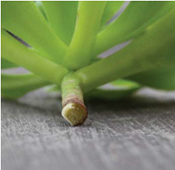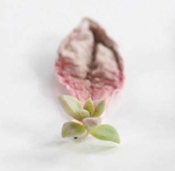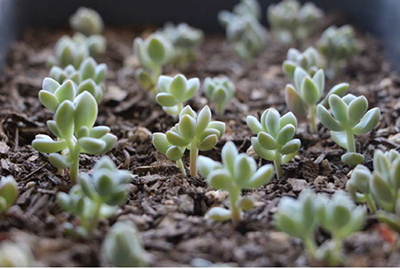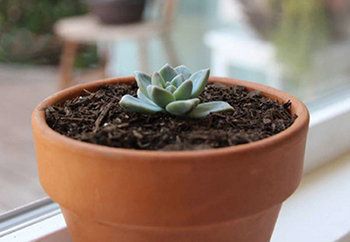
What’s propagation? Basically, creating new plants from seeds, leaves, cuttings, or other parts of existing plants. Many of the projects in this book will require cuttings, meaning you may need to cut an offshoot from its mother plant or cut a smaller plant from its root system. Taking succulent cuttings is a super easy way to multiply your plants with little time, effort, or money! Unlike flowers, which fade and wither away once cut, succulent cuttings will take root and thrive if given the proper care.

Even if you keep succulents in bright windows that get plenty of light, they can sometimes still get “leggy.” This happens when a plant isn’t getting enough light and it starts to stretch out, causing the stem to grow long and the leaves to become widely spaced.
If you have a plant that is starting to become leggy like this one, have no fear. This is the perfect time to propagate!
Although your plant may still look gorgeous from the top, the lower leaves will begin to wither and fall off over time and you will be left with a rosette high above the soil on a long, bare stem. Before the leaves start to die, let’s pull them off and propagate them to make more plants.

Notice the long stem and widely spaced leaves.

This plant is an ideal candidate for propagation because it still looks great from the top.
Remove the lower leaves first. Be really careful when you remove the leaves from the stem. I hold the leaf firmly and wiggle it from side to side until I feel a little snap. For most succulents, you can even just push the leaf in either direction with one finger and the leaf will come off. You want to be sure to get the entire leaf. If you rip the leaf, leaving the base still attached to the stem, it will not be able to grow roots or a new plant.

Gently wiggle the leaf to remove it.

This is what the leaves will look like if they are properly pulled from the stem remaining fully intact.
After you have successfully removed the lower leaves you will be left with a small rosette on a long, bare stem. This is where you will cut. I like to call the next step decapitation propagation. I’m not sure if that’s the technical term, but it rhymes and we’re going to cut its head off, so . . .

I use a pair of craft scissors, but a sharp knife would work great as well.

We now have a bunch of leaves, a stump, and a cute little plant with a short stem.
Now, you wait. Before you can place the leaves and rosette in soil to begin growing new plants, you must let the ends dry out and callus over. This step is vital! If you don’t let the ends dry out, they will absorb too much moisture, which will cause them to rot and die. The drying process could take anywhere from a few days to a week or so, depending on the type of plant and how thick the stem is.

The freshly cut stem will be wet and fleshy.

You will know you have waited long enough when the end of your stem has visibly dried out.
Once the ends of the leaves have had time to callus over, you can place them on top of some well-draining cactus or succulent soil. (Some people dip the ends of the leaves and stem in a rooting hormone, but I’ve had great success without it.) Keep the leaves indoors in a window with lots of indirect sunlight. There is no need to water the ends of the leaves until you begin to see roots or baby plants growing from them.
After a few weeks, you will see little pink roots sprouting from the ends of the leaves. Then, teeny tiny baby plants will begin to grow. It will look like a miniature succulent sprouting from the end of the leaf.
Once you see roots or baby plants, leave them lying on top of the soil and you may begin watering. Give them a good soak about once a week or whenever the soil is totally dry. Just as with a fully developed succulent, too much water is not good. If you want to be certain not to overwater, mist the roots growing from your leaves with a spray bottle once a day instead of completely saturating the soil.

A plant with roots.

This leaf grew a baby plant first and no roots.
Let the baby plants grow until you notice the “mother leaf” starting to wither. At that point, you can carefully remove the leaf in the same fashion you removed it from the original stem, and then place the baby plant in its own pot. Removing the original leaf can be tricky, as you don’t want to accidentally remove the roots with the leaf. If you give it a gentle wiggle and it doesn’t come off, you may want to play it safe and let the leaf fall off on its own.
Keep in mind, not every leaf will grow a new plant. I’ve found that some leaves just wither away, some will take root while never growing a new plant, and some might even grow a plant but never root. Although there will typically be a small amount of losses, most leaves will grow roots followed by a new plant.

I ran out of individual little pots with this batch, so I just removed the leaves as they withered and left the plants to grow together like a little succulent forest.
Okay, back to that stump. Don’t worry, no part of this plant is going to go to waste!
Simply put this pot aside and eventually it will begin to sprout new plants. Babies may potentially grow from each place we removed a leaf!

New growth.
Now back to our cutting, the reason we did all of this! Once the stem has dried out and callused over, simply place the plant back in a pot with well-draining cactus or succulent soil and it will grow roots again and continue to flourish!
